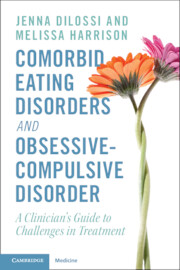 Comorbid Eating Disorders and Obsessive-Compulsive Disorder
Comorbid Eating Disorders and Obsessive-Compulsive Disorder from Part I - Overview of the Existing Literature
Published online by Cambridge University Press: 14 December 2023
While there is a high rate of comorbidity between EDs and OCD, there is limited research on how to treat this comorbidity. Evidence-based treatments for EDs share many core tenets, though it is unclear which treatment features are necessary. CBT-E and FBT both focus on maintenance mechanisms, alliance building and providing a strong rationale for change. For underweight patients, they target weight gain and use in-session, collaborative weighing and weight graphs to document progress. Both focus on dietary restraint and restriction early on, and FBT indirectly and CBT-E directly target body checking, body avoidance, and social comparison behaviors. Both treatments prepare for relapse prevention and termination. There are similarities between the treatments for OCD and EDs, such as focusing on session agendas, providing structure and expectations for treatment, psychoeducation, a collaborative therapeutic relationship, and self-monitoring. CBT-E uses hierarchies and targets body checking and body avoidance similar to therapy for OCD. Both CBT-E and OCD treatments include elements of cognitive therapy, using corrective learning and behavioral experiments.
To save this book to your Kindle, first ensure [email protected] is added to your Approved Personal Document E-mail List under your Personal Document Settings on the Manage Your Content and Devices page of your Amazon account. Then enter the ‘name’ part of your Kindle email address below. Find out more about saving to your Kindle.
Note you can select to save to either the @free.kindle.com or @kindle.com variations. ‘@free.kindle.com’ emails are free but can only be saved to your device when it is connected to wi-fi. ‘@kindle.com’ emails can be delivered even when you are not connected to wi-fi, but note that service fees apply.
Find out more about the Kindle Personal Document Service.
To save content items to your account, please confirm that you agree to abide by our usage policies. If this is the first time you use this feature, you will be asked to authorise Cambridge Core to connect with your account. Find out more about saving content to Dropbox.
To save content items to your account, please confirm that you agree to abide by our usage policies. If this is the first time you use this feature, you will be asked to authorise Cambridge Core to connect with your account. Find out more about saving content to Google Drive.